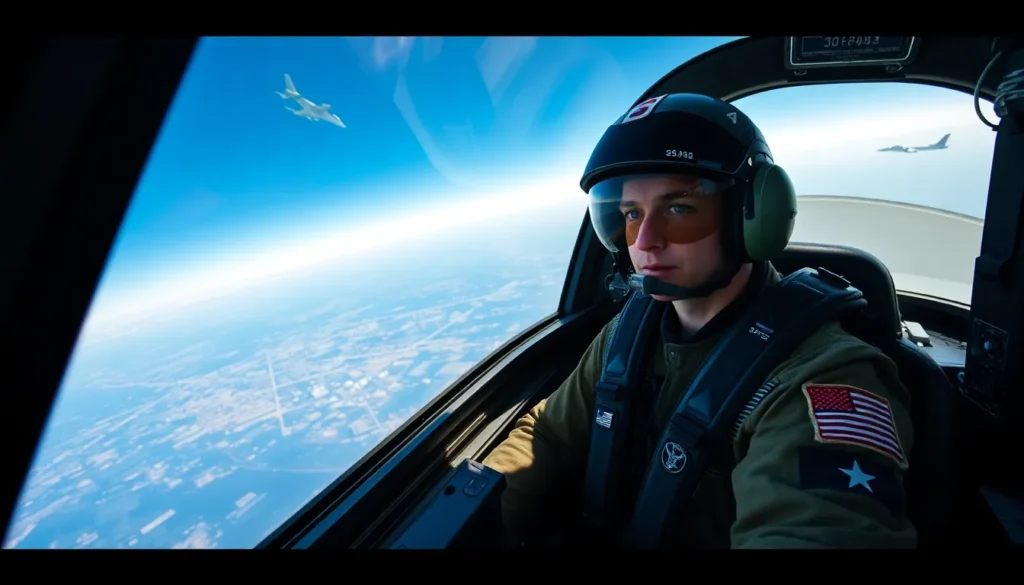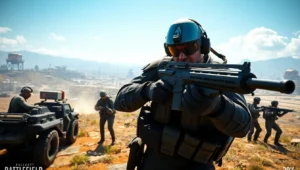Strap in and prepare for takeoff because battlefield pilot gameplay is about to take you on a wild ride! Whether you’re soaring through the skies or dodging enemy fire, there’s nothing quite like the adrenaline rush of piloting a virtual aircraft in a chaotic warzone. Forget about mundane tasks; this is where the real action happens, and the only thing that matters is your skill, reflexes, and maybe a little bit of luck.
Table of Contents
ToggleOverview of Battlefield Pilot Gameplay
Battlefield pilot gameplay immerses players in the unique experience of flying various aircraft in intense combat scenarios. Pilots control fighters, bombers, and transports to navigate complex battlefields. Mastering the flight mechanics proves crucial for gaining an advantage in aerial engagements.
Players must learn to skillfully maneuver aircraft while evading enemy fire. Precision becomes essential when targeting opposing forces or supporting ground troops. Communication with teammates facilitates coordination during missions, enhancing overall effectiveness.
Aircraft play distinct roles, from stealth bombers delivering heavy payloads to fighter jets intercepting adversaries. Each plane comes equipped with special capabilities and weaponry, catering to different strategies. Understanding these attributes can lead to smarter gameplay decisions.
The environment presents constant challenges. Weather conditions fluctuate, impacting visibility and flight dynamics. Pilots also contend with evolving battlefield scenarios, where objectives may change rapidly. Adaptability becomes vital for maintaining effectiveness in diverse situations.
Aerial dogfights demand quick reflexes and strategic thinking. Engaging in combat requires players to choose between aggressive tactics and evasive maneuvers. Successful pilots often anticipate enemy actions, making split-second decisions critical for survival.
Scoring points in battlefield pilot gameplay enhances the competitive element. Players earn rewards for successful missions, downed aircraft, and teamwork. Higher scores unlock additional resources for customizing and upgrading aircraft.
Participating in this adrenaline-fueled experience, pilots continue to refine their skills. They learn from each flight, gaining insights that improve their gameplay. The thrill of aerial combat drives players to return and face new challenges, ensuring an engaging gaming experience.
Key Features of Battlefield Pilot Gameplay

Battlefield pilot gameplay immerses players in the exhilarating world of aerial combat, where mastering distinct aircraft plays a critical role in mission success.
Aircraft Selection
Players can choose from a variety of aircraft, including fighters, bombers, and transport planes. Each type offers unique roles tailored to specific gameplay strategies. Stealth bombers excel in undetected strikes, while fighter jets dominate in fast-paced dogfights. Transports support ground units, facilitating troop deployments and resupply missions. Understanding the strengths and weaknesses of each aircraft type leads to improved tactical decisions in chaotic battle scenarios. Pilots must assess their team’s needs and adapt their selections accordingly to enhance overall effectiveness.
Controls and Mechanics
Control schemes vary, providing a customizable experience for pilots. Precision in flight mechanics is vital, influencing speed and maneuverability during intense engagements. Players engage in complex aerial maneuvers, requiring diverse skills to evade enemy fire and effectively target opponents. Understanding weight and balance significantly impacts handling during flight, demanding quick reflexes. Experimentation with controls enables pilots to find the setup that best suits their playstyle. Continuous practice sharpens their abilities, preparing them for the demands of unpredictable battlefield conditions.
Strategies for Success in Battlefield Pilot Gameplay
Success in battlefield pilot gameplay relies heavily on strategy. Understanding team dynamics and environment plays a vital role.
Team Coordination
Effective team coordination maximizes aerial effectiveness. Players should communicate regularly about enemy positions and tactical movements. Using voice chat or in-game markers enhances situational awareness. Pilots can share critical information about air support and ground troop locations. Collaborative sorties yield better outcomes, as coordinated attacks often catch enemies off guard. Group engagement allows for diverse roles, where fighters cover bombers and transports. The ability to adapt tactics based on teammate actions can determine mission success. Staying connected encourages teamwork and improves overall performance.
Map Awareness
Map awareness significantly influences gameplay outcome. Recognizing key areas, such as choke points and cover zones, provides strategic advantages. Familiarity with terrain enables better flight paths and escape routes. Players should pay attention to the minimap for enemy movements and objectives. Analyzing potential ambush sites can minimize risk during maneuvers. Weather patterns also affect visibility and flight performance; pilots must adapt quickly. Players benefit from memorizing spawn points and resource locations for tactical planning. Heightened awareness leads to informed decisions during engagements, enhancing chances of victory.
Common Challenges Faced
Navigating the complexities of battlefield pilot gameplay introduces several challenges that pilots encounter regularly.
Enemy Engagements
Engaging with enemy aircraft proves daunting. Pilots must constantly adapt to opponent tactics and maneuvers. Each aerial dogfight calls for quick reflexes and strategic planning. High-pressure situations often lead to split-second decisions that can determine victory or defeat. Enemy pilots might employ ambush tactics, requiring vigilance and situational awareness. Understanding enemy aircraft strengths helps in formulating counter-strategies. Additionally, cooperative play facilitates effective targeting, enhancing the chances of success against superior numbers. Successfully outmaneuvering adversaries demands practice, skill, and a readiness to learn from each flight.
Environmental Hazards
Environmental factors significantly impact gameplay. Weather conditions can vary widely, affecting visibility and aircraft performance. Pilots confront turbulent winds and adverse weather, which challenge control and maneuverability. Terrain such as mountains and forests adds another layer of complexity; valleys may conceal threats while high altitudes require careful navigation. Recognizing these hazards is essential for successful aerial operations. Environments can greatly influence battle outcomes, making map knowledge critical. Utilizing terrain effectively offers strategic advantages against opponents. Adapting tactics based on environmental conditions enhances overall performance.
Tips for New Pilots
Mastering aerial maneuvers starts with familiarizing oneself with controls. Understanding customizable control schemes leads to a more comfortable flying experience. Practice frequently, as regular engagement improves reflexes and confidence during intense dogfights.
Choosing the right aircraft proves vital; each type has unique strengths. Stealth bombers excel in undetected strikes, while fighter jets offer agility for evasive maneuvers. Adapting to situations ensures maximizing the potential of the selected aircraft.
Communicating effectively with teammates enhances overall mission effectiveness. Coordinate attacks to surprise opponents, as teamwork often leads to victory. Maintaining situational awareness allows pilots to monitor enemy movements and react promptly.
Familiarity with the map significantly benefits gameplay. Recognizing key locations and understanding terrain leads to strategic advantages. Observing weather conditions can influence decisions, so staying alert enhances performance.
Avoiding head-on engagements with multiple enemies is essential for survival. Instead, using evasive tactics increases the chances of escape. Targeting isolated opponents may yield better outcomes in fights.
Recognizing environmental hazards contributes to successful operations. Factors like poor visibility and challenging terrain affect aircraft performance. Using terrain strategically can create opportunities for ambushes and offers an edge against enemy forces.
Above all, patience remains a crucial component for new pilots. Taking time to learn from mistakes allows for improvement. Embracing challenges builds resilience and enhances performance in the long run.
Battlefield pilot gameplay offers a thrilling blend of strategy and skill that keeps players engaged. The intense aerial combat demands quick reflexes and adaptability as pilots navigate complex environments while coordinating with teammates. Mastering different aircraft and their unique capabilities enhances the overall experience and allows for diverse tactical approaches.
As players refine their skills through practice and experimentation, the excitement of each flight becomes a driving force. The dynamic nature of the battlefield ensures that no two missions are the same, presenting fresh challenges that test both individual abilities and teamwork. Embracing these challenges ultimately leads to greater rewards and a deeper appreciation for the art of aerial warfare.





